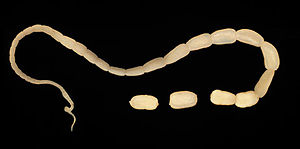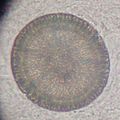Cucumber seed tapeworm
| Cucumber seed tapeworm | ||||||||||||
|---|---|---|---|---|---|---|---|---|---|---|---|---|

Cucumber seed tapeworm |
||||||||||||
| Systematics | ||||||||||||
|
||||||||||||
| Scientific name | ||||||||||||
| Dipylidium caninum | ||||||||||||
| ( Linnaeus , 1758) Leuckart , 1863 |
The cucumber seed tapeworm (also pumpkin seed tapeworm , Dipylidium caninum ) is the most common tapeworm in dogs and occurs worldwide. Occasionally this tapeworm also occurs in cats. Intermediate hosts are fleas or animal lice of the suborder Ischnocera of the dog or the cat. The worm eggs are ingested by the flea larvae and develop into cysticercoids in them . By eating the fleas, these tapeworm stages get into the dog's intestines and develop into an adult tapeworm in 20 days. This is 10–70 centimeters long and 2 to 3 millimeters wide. When the fleas move to other dogs (or cats), it spreads further in the population.
The clinical picture corresponds to that of other tapeworm diseases in dogs or cats . Diseases in humans, especially in children, are also rarely observed. This is called dipylidiasis .
In the event of an infection caused by the cucumber seed tapeworm that requires treatment, praziquantel or niclosamide are used as antiparasitic drugs .
Cucumber seed tapeworm (at the bottom of the picture) and severe roundworm infestation in a cat in the vomit.
literature
- Thomas Schnieder et al .: Veterinary Parasitology . Parey-Verlag, 6th edition, 2006. ISBN 3830441355 .
Individual evidence
- ^ Marianne Abele-Horn: Antimicrobial Therapy. Decision support for the treatment and prophylaxis of infectious diseases. With the collaboration of Werner Heinz, Hartwig Klinker, Johann Schurz and August Stich, 2nd, revised and expanded edition. Peter Wiehl, Marburg 2009, ISBN 978-3-927219-14-4 , p. 290.



